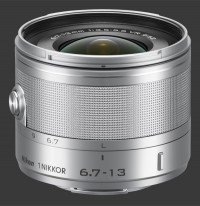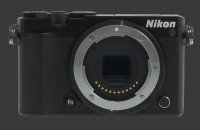Nikon 1 J5 Review
Nikon 1 J5 Performance - How well does it take pictures?
Performance starts with image quality, which is the criteria used as the foundation of our digital camera ratings. Ergonomic issues may get in the way, but in the end, image quality counts the most. For an ILC, image quality greatly depends on the lens used. While color, noise, exposure and dynamic-range are properties of a camera, distortion, vignetting and chromatic aberrations are properties of the lens. Sharpness and contrast depend on the weakest link. That is, a camera cannot capture more details than a lens lets through. Conversely, it is possible for a lens to transmit more details than a sensor can capture.
Image Noise & Details
The Nikon 1 J5 shows virtually no image-noise until ISO 400, with ISO 800 only showing a very fine noise-pattern at 100%. Considering the resolution has even increased compared to the J4, this is a dramatic improvement. There is no sign of noise-reduction softness at these sensitivities either. It can produce very nice large prints up to 20" x 15".

Noise starts becoming noticeable at ISO 1600. Contrast and dynamic-range are only slightly reduced, while the finest detail start being affected. Relatively large prints are still easily possible. ISO 3200 is a little more noisy but completely usable for mid-size prints. This is very impressive for comparatively small sensor.
ISO 6400 is where image quality noticeably drops. Images still show good contrast and dynamic-range though. As details get eaten by noise, ISO 6400 should be limited to mid-size prints, up to about 12" x 8". ISO 12800 display strong noise plus some noise-reduction softness, yet it remains usable for the smallest print-sizes.
The J5 adds two noise-reduction sensitivities, ISO 6400 and 12800, where it heavily processes noise out.. This produces extremely soft looking images which, however, can be used for emergencies in very small print sizes or for web use.
Sharpness on the J5 is adjustable in 10 levels. It starts at extremely soft and sharpens until there is severe over-sharpening. At a setting of 4, details are nice and sharp without showing any sharpening artifacts. As usual, the lens must be sufficiently stopped down from its brightest to let sufficient details through.

Color & White Balance
This digital camera performs reasonably in terms of colors. Neutral mode provides colors which resemble reality the most. There is a warm tone by default which is easily corrected by adding +1 to Hue. Default Saturation, Contrast and Brightness are all good though.
The J5 has an a good Auto White-Balance system. It manages to produce neutral colors in typical conditions while leaving only a slight cast under low artificial light. This time, WB preview works as expected, so there are little surprises when reviewing images.

Exposure
The Nikon Matrix metering system used by the Nikon 1 J5 is exceptionally good. Exposure is quite consistent and accurate. Highlights are not blown out very often while results are generally bright enough to be usable as is. There is no Live-Histogram to preview exposure, nor is there an Exposure-Priority preview.
Auto Focus
The Nikon 1 J5 uses a fast hybrid autofocus system with both Phase-Detection and Contrast-Detection. Phase-Detection is done with 105 points right on the sensor, while Contrast-Detection is measured at 171 areas. This digital camera decides which one to use depending on available light.

Phase-Detection has the advantage of being faster and not needing back and forth lens movements to confirm focus. The latter point is particularly important during video which gets recorded as the camera focuses. When light is too low, the camera switches to Contrast-detection.
Autofocus speeds, because of the hybrid system, are variable. When light is good to moderately low, this Nikon focuses extremely quickly. Even under typical household lighting, this camera manages to lock focus faster than any mirrorless. As light levels drop and the camera switches to Contrast-Detection, things slow down gradually. When light is low, it still manages impressively well.
Speed
The Nikon 1 J5 is generally fast. Most controls gets an instant response, although there is a shutter-lag which was not observed on previous generations of Nikon 1 cameras. With Phase-Detection, autofocus even compares well to advanced DSLRs. This is a good performance for a mirrorless camera. These measurements characterize the performance of the J5:
- Power-On: 1 seconds. Reasonable.
- Power-On to First-Shot: 1½s. Good.
- Autofocus: Under ½s in good to moderate light. Rarely exceeds ¾s except in very low light. Very good.
- Shutter-lag: Perceptible but less than ¼s. Average.
- Blackout: None with Instant Review disabled. Outstanding. There is ½s blackout before Instant Review though which is slightly below average.
- Shot-to-shot: A little over ½s. Above average. Only with Instant Review disabled though.
- Video: ½s Start delay and ½s cut-off when stopping. Slow.
- Playback: Instant to enter or exit. Excellent.
- Power-Off: Under ½s. Excellent.
The performance of the J5 closely matches its predecessor. Autofocus and shot-to-shot speeds remain impressive. There is an improvement in startup time, while video has acquired an unfortunately delay when starting. This is slight more pronounced at 4K than HD though. The main culprit is Instant Review which adds an unfortunate black-out and cripples shot-to-shot speeds. With Instant Review disabled, the speed of the Nikon 1 J5 is impressive.
Battery-life of the Nikon 1 J5 is quoted at 250 shots-per-charge. This is quite below average. It probably will not make it through a full day of shooting, so a second battery is strongly recommended.
Nikon 1 J5 Performance - How well does it shoot video?
The Nikon 1 J5 is the first Nikon camera to capture 4K Ultra-HD video. The J5 records a 3840x2160 crop from its sensor at 15 FPS. Given that the J5 has a 20 MP sensor which produces images of 5568x3712, this results in a further 1.45X crop. For works out nicely with the ultra-wide Nikkor 1 6.7-13 F/3.5-5.6 VR
Nikkor 1 6.7-13 F/3.5-5.6 VR. A standard zoom though will be too narrow for general purpose filming though.
Ultra-HD video from the J5 capture a stunning amount of details. Edges and fine patterns are rendered perfectly because the J5 does not skip pixels or down-scale the sensor output, which are the advantages of using a sensor-crop rather than its full-area. Compression quality is good with videos saved as Quicktime with H.264 codec. This processing is quite intensive and so the J5 limits 4K video to a maximum of 10 mins. The slow 15 FPS frame-rate of course makes motion look choppy, particularly when panning.

Full HD capabilities of the 1-series of mirrorless cameras are also present in the J5. It can record 1080p @ 60 FPS with lower frame-rates and resolutions available to save memory-space. This frame-rate captures motion extremely smoothly. Interestingly, it takes the same amount of bandwidth to record 4K @ 15 FPS than 1080p @ 60 FPS, which the J5 can sustain for several minutes.
There are plenty of additional video modes, including Time Lapse Video which is captured at 1920x1080 and played back at 10 FPS from whatever frames were captured by the Interval Timer function. Fast-Speed video records at 5 FPS and plays back at 30 FPS, giving a 6X speed up. This can make scenes appear more active.
Slow-Motion video works by recording at high-speed and playing back at 30 FPS. There are 3 options to choose from: 1280x720 @ 120 FPS, 640x240 @ 400 FPS and 320x120 @ 1200 FPS which gives a slow-down between 4X and 40X. Note that the resolution is extremely and the aspect-ratio is unusual for the two fastest modes. Sound is obviously not available in these modes.
While video quality is high on the Nikon 1 J5, there is a ½s lag at the start of filming. At least, with a dedicated Video mode, setting up framing correctly is possible before recording starts. Stopping happens almost instantly with roughly ½s chopped from the end of clips. Autofocus during video is very good as this mirrorless uses on-sensor Phase-Detect AF. It adjusts focus smoothly and quietly, locking on after a very short delay.
Nikon 1 J5 Conclusion

The Nikon 1 J5 presents a good leap for the Nikon 1 lineup. Image quality seriously jumped ahead with the new 20 megapixels sensor which allows for large prints up to ISO 800 and mid-size prints several stops beyond that. Several aspects of image-quality are also improved, including dynamic-range, contrast and white-balance.
Ergonomics are completely redesigned and provide a much more intuitive interface than before. Having dual control-dials on an entry-level camera is uncommon, yet they make changing parameters quite efficient. The traditional mode-dial added on the J5 also saves many trips to the menu system which everyone will appreciate.
The J5 offers a really fast hybrid 171-area and 105-point autofocus system. It locks focus quickly for both still and video. The rest of the J5 is very fast too, with up to 60 FPS continuous shooting at full-resolution which still runs at an impressive 20 FPS with Continuous AF enabled.
The headline 4K Ultra-HD capture delivers high-quality videos with two caveats. The most obvious one is a cropped field-of-view. The other is a 15 FPS frame-rate which makes motion choppy. It is a good start but the full 1080p HD mode is considerably more versatile.
The main complaints for the J5 are about its display. The view does not show 100% coverage and is still not Exposure-Priority, although it does preview WB correctly now. In low-light, the preview is too dark and visibility is not ideal in bright light either. The touchscreen function is pretty much useless as it easily takes unwanted shots.
The Nikon 1 J5 is impressive in its combination of image-quality, speed and compactness. It packs a high number of features in a small form-factor with a relatively easy to operate design. The 2.7X crop sensor allows the Nikon 1 system to offer much smaller lenses than nearly all other mirrorless systems, also contributing to keeping total bulk low.
 |
Please Support Neocamera
All information on Neocamera is provided free of charge yet running this website is a huge endeavor. Purchases made via affiliate links found throughout the site help keep it running and up-to-date. There is no additional cost to you, so please consider buying via these links to our affilates:
If you found any information on this site valuable and did not purchase via our affiliate links, please considering donating via PayPal:
Any amount will be greatly appreaciated. Thank you for your support!
Nikon J5 Highlights

Sensor-Size: 13 x 9mm

Actual size when viewed at 100 DPI
| 20 Megapixels Mirrorless | ISO 160-12800 |
| Nikon 1 Mount 2.7X FLM | Shutter 1/16000-30s |
| 60 FPS Drive, 20 Images | Full manual controls, including Manual Focus |
| 3840x2160 @ 15 FPS Video Recording | Custom white-balance with 2 axis fine-tuning |
| 3" LCD 1 Megapixels | Spot-Metering |
| Lithium-Ion Battery | |
| Micro Secure Digital Extended Capacity |
Updates
2025.01.18

Fujifilm GFX 2025 Lens Roundup
Lens Review roundup of Fujifilm GFX Medium-Format lenses. Quality, performance and handling of the GF20-35mm F/4R WR, GF30mm F/3.5 Tilt-Shift and the GF55mm F/1.7.
2024.11.18

Best 2024 Photography Gifts for Every Budget
Great gifts for photographers and photo enthusiasts selected for every budget among the best products of 2024.
2024.08.07

Eye Protection Tips for Professional Photographers
The four main considerations for professional photographers regarding eyewear.
2024.07.14

Fujifilm X100VI Review
Flagship fixed-lens compact digital camera with a 40 MP sensor and Image-Stabilization, a first for the series. Retro design featuring dual control-dials, plus direct ISO, Shutter-Speed and EC dials. Its hybrid viewfinder can switch between EVF and OVF mode.
2024.05.09

Fujifilm GFX100 II Review
Flagship 102 Megapixels Medium-Format Mirrorless Digital Camera with 8-Stop 5-Axis IBIS, 8 FPS Drive, 8K Video and 400 MP Super-Resolution capture in a weatherproof and freezeproof body with dual control-dials and dual memory-card slots.
2024.04.03

Fujifilm X-T5 Review
Newest Fujifilm flagship boasting a 40 MP APS-C sensor, 5-axis IBIS with 7-stop efficiency, 15 FPS continuous drive, 6.2K Video capture, dual control-dials and dual SDXC UHS-II slots in a sturdy weatherproof and freezeproof body.
2023.11.20

Best Digital Cameras of 2023
Find out which are the Best Digital Cameras of 2023. All the new Mirrorless Digital Cameras from entry-level to high-end professional.
2023.07.10

Fujifilm X-H2 Review
40 Megapixels APS-C Hybrid Mirrorless Digital Camera with 7-stop IBIS. Fastest shutter ever and 8K video capture. Large builtin EVF with 0.8X magnification and 5.8 MP, plus an Eye-Start Sensor. Packed with features and large number of controls in a weatherproof and freezeproof body.
2023.05.07

Sony FE 20-70mm F/4G Review
Review of the unique Sony FE 20-70mm F/4G lens. The optical zoom of this lens spans ultra-wide-angle and medium focal-length coverage, making it one of the most versatile Full-Frame lenses on the market.
2023.01.15

Huion Inspiroy Dial 2 Review
Review of the Huion Inspiroy Dial 2 tablet, a medium sized drawing surface with dual dials and customizable buttons. Connects via USB-C or Bluetooth 5.0 with Windows, Linux and Android support.
2022.12.08

How to Pack for a Photo Trip
Find out how to pack for a travel photography trip, carry your gear safely while meeting airline regulations.
2022.11.13

Best Digital Cameras of 2022
The best digital cameras of 2022. A short list of the most outstanding models in their respective categories. Choose one for yourself or as a gift.












